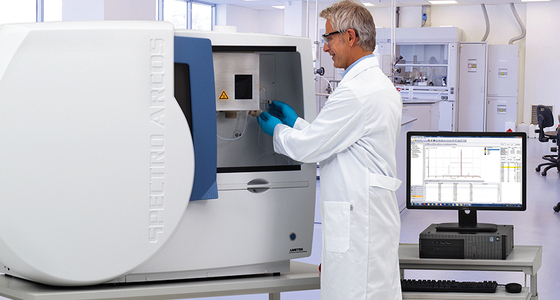Inductively Coupled Plasma Optical Emission Spectroscopy
Inductively Coupled Plasma Optical Emission Spectroscopy (ICP-OES) can provide quantitative bulk elemental composition of a wide variety of sample types, including powders, solids, liquids and suspensions. Solid samples are generally dissolved or digested using a combination of acids in a closed microwave system, thus retaining potentially volatile analyte species. The resulting sample solution is then nebulized into the core of an inductively coupled argon plasma, where temperatures of approximately 9000 K are attained. At such high temperatures, the nebulized solution is vaporized, and the analyte species are atomized, ionized and thermally excited. The analyte species can then be detected and quantitated with an optical emission spectrometer (OES), which measures the intensity of radiation emitted at the element-specific, characteristic wavelength from thermally excited analyte atoms or ions. Intensity measurements are converted to elemental concentration by comparison with calibration standards. This technique is especially powerful for quantitative chemical analysis when standards are not available.

Ideal Uses of IC-OES
- Bulk quantitative chemical analysis of major, minor and trace elements in solids, liquids and suspensions
- Precise and accurate determination of major and minor elements in a wide range of materials
- Quality control and process control, and research and development
Strengths
- A range of elements can be measured in a single analysis cycle
- The useful linear dynamic range is over several orders of magnitude
- The use of a quartz-free sample introduction system enables determination of low levels of silicon and boron
- The analysis can be automated, enhancing accuracy, precision and sample throughput
- The combination of ICP-OES and ICP-MS is very powerful for determining a wide range of elemental concentrations, from major components to trace level components (typically sub-ppb) with high accuracy and precision
Limitations
- The sample portion to be analyzed must be completely digested or dissolved prior to analysis
- Emission spectra can be complex, and spectral interferences are possible if the wavelength of the element of interest is very close to or overlaps that of another element
- Matrix-related effects can create challenges in quantitation
- Carbon, nitrogen, hydrogen, oxygen and halogens cannot be determined using this technique
IC-OES Technical Specifications
- Signal Detected: Photons
- Sample Size Requirement: 250 mg to 1 gram of solid sample; typical solution volumes range from 2-10 mL
- Range of Elements Detected: Lithium (atomic number 3) to uranium (atomic number 92), except gases, halogens, low levels of phosphorous and sulfur
- Typical Detection Limits: Parts per billion in solution
- Depth Resolution: Bulk chemical analysis technique
- Spatially Resolved Analysis: No
- Imaging/Mapping: Ns
